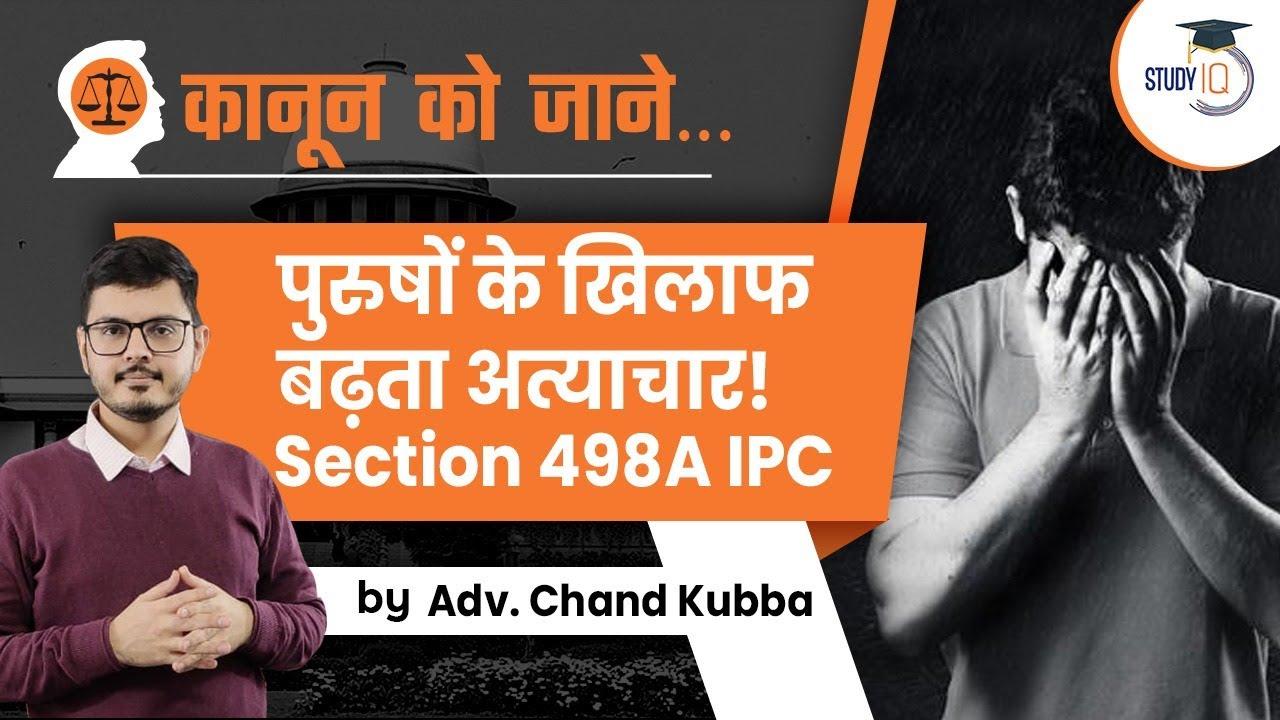Major Problem in Society-
- The is a predominant presumption that spousal abuse is something that is faced by only one gender. No, That’s not true.
- There is this preconceived notion in our society that men are supposed to be strong, mighty and they are generally supposed to bottle up their emotions.
- If they show their vulnerabilities, they are labelled as being sissy, effeminate, and many other derogatory terms.
Law Providing protection to women –
- Dowry Prohibition Act 1961
- Domestic Violence Act 2006
- Section 498 A-introduced in 1983
Husband or relative of husband of a woman subjecting her to cruelty.—Whoever, being the husband or the relative of the husband of a woman, subjects such woman to cruelty shall be punished with imprisonment for a term which may extend to three years and shall also be liable to fine.
- Explanation.—For the purposes of this section, “cruelty” means— (a) anywilful conduct which is of such a nature as is likely to drive the woman to commit suicide or to cause grave injury or danger to life, limb or health (whether mental or physical) of the woman; or
- (b) harassment of the woman where such harassment is with a view to coercing her or any person related to her to meet any unlawful demand for any property or valuable security or is on account of failure by her or any person related to her to meet such demand.
- 498A is a Cognizable offence, where by Police official can arrest an accused without any warrant and non-bailable offence.
- While Supreme Court has identified the misuse of the section as ‘legal terrorism’, several governments have failed to address the issue for fear of being called anti-women and losing out on their vote bank.
- On one hand the Law provides lasting power to women to speak up against any discrimination they are subjected to, on the other hand, it conveniently ignores how it makes the male gender vulnerable.
In the case of Arnesh Kumar v. State of Bihar 2014
- A two-judge bench of the Supreme Court observed that the Section 498A had become a powerful weapon for disgruntled wives, where innocent people were arrested without any evidence due to non-bailable and cognizablenature of the law .
- The Supreme Court said that the anti dowry law (Section 498A) is being used by some women to harass their husband and in-laws
- The court asked the police to follow Section 41 of the Code of Criminal Procedure, 1973, which provides a 9-point checklist which must be used to decide the need for an arrest.
- the judgement mentioned that even bedridden grandfathers and grandmothers and even relatives residing abroad were arrested
Other Cases
- Manju Ram Kalita v. State of Assam (2009) 13 SCC 330
- Bibi Parwana Khatoon v. State of Bihar (2017)
- Rajesh Kumar & Ors v. Sate of U.P. (2017)
- In 2016, Government admitted in Rajya Sabha that “some times” provisions of the Domestic Violence and Anti-Dowry Acts were misused and several NGOs had also given reports supporting it.
- MoS (Home) Kiren Rijiju said that only 13 persons were convicted out of the 639 charge sheeted in 2014 under the Protection of Women from Domestic Violence Act 2005.
Men Also Face Violence –
- PGIMS, Rohtak And Maharishi Markandeshwar Institute of Medical Science and Research, Ambala Professors conducted A cross-sectional study of gender-based violence against men in the rural area of Haryana in 2019-
- 52.4% of men experienced gender-based violence.
- Out of 1000, males 51.5% experienced violence at the hands of their wives/intimate partner at least once in their lifetime and 10.5% in the last 12 months.
- The most common spousal violence was emotional (51.6%) followed by physical violence (6%). Only in one-tenth cases, physical assaults were severe.
Section 3 DVA defines Violence as –
- Domestic Violence shall constitute
- (a) harms or injures whether mental or physical, and includes causing physical abuse, sexual abuse, verbal and emotional abuse and economic abuse;
- “sexual abuse” includes any conduct of a sexual nature that abuses, humiliates, degrades or otherwise violates the dignity of woman;
- “verbal and emotional abuse” includes—(a) insults, ridicule, humiliation, name calling and insults or ridicule specially with regard to not having a child or a male child; and
- repeated threats to cause physical pain to any person in whom the aggrieved person is interested.
- “economic abuse” includes—(a) deprivation of all or any economic or financial resources to which the aggrieved person is entitled under any law
- Disposal of household effects, any alienation of assets whether movable or immovable, valuables, shares, securities, bonds.






















 WhatsApp
WhatsApp